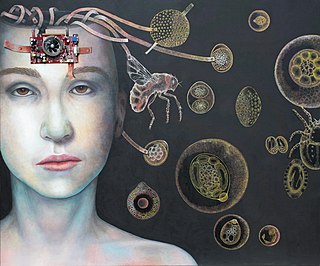Related Research Articles

Parasitism is a close relationship between species, where one organism, the parasite, lives on or inside another organism, the host, causing it some harm, and is adapted structurally to this way of life. The entomologist E. O. Wilson has characterised parasites as "predators that eat prey in units of less than one". Parasites include single-celled protozoans such as the agents of malaria, sleeping sickness, and amoebic dysentery; animals such as hookworms, lice, mosquitoes, and vampire bats; fungi such as honey fungus and the agents of ringworm; and plants such as mistletoe, dodder, and the broomrapes.

In biology and medicine, a host is a larger organism that harbours a smaller organism; whether a parasitic, a mutualistic, or a commensalist guest (symbiont). The guest is typically provided with nourishment and shelter. Examples include animals playing host to parasitic worms, cells harbouring pathogenic (disease-causing) viruses, a bean plant hosting mutualistic (helpful) nitrogen-fixing bacteria. More specifically in botany, a host plant supplies food resources to micropredators, which have an evolutionarily stable relationship with their hosts similar to ectoparasitism. The host range is the collection of hosts that an organism can use as a partner.

In evolutionary ecology, a parasitoid is an organism that lives in close association with its host at the host's expense, eventually resulting in the death of the host. Parasitoidism is one of six major evolutionary strategies within parasitism, distinguished by the fatal prognosis for the host, which makes the strategy close to predation.

Parasitology is the study of parasites, their hosts, and the relationship between them. As a biological discipline, the scope of parasitology is not determined by the organism or environment in question but by their way of life. This means it forms a synthesis of other disciplines, and draws on techniques from fields such as cell biology, bioinformatics, biochemistry, molecular biology, immunology, genetics, evolution and ecology.

Brood parasites are animals that rely on others to raise their young. The strategy appears among birds, insects and fish. The brood parasite manipulates a host, either of the same or of another species, to raise its young as if it were its own, usually using egg mimicry, with eggs that resemble the host's.

A hyperparasite, also known as a metaparasite, is a parasite whose host, often an insect, is also a parasite, often specifically a parasitoid. Hyperparasites are found mainly among the wasp-waisted Apocrita within the Hymenoptera, and in two other insect orders, the Diptera and Coleoptera (beetles). Seventeen families in Hymenoptera and a few species of Diptera and Coleoptera are hyperparasitic. Hyperparasitism developed from primary parasitism, which evolved in the Jurassic period in the Hymenoptera. Hyperparasitism intrigues entomologists because of its multidisciplinary relationship to evolution, ecology, behavior, biological control, taxonomy, and mathematical models.

Orobanchaceae, the broomrapes, is a family of mostly parasitic plants of the order Lamiales, with about 90 genera and more than 2000 species. Many of these genera were formerly included in the family Scrophulariaceae sensu lato. With its new circumscription, Orobanchaceae forms a distinct, monophyletic family. From a phylogenetic perspective, it is defined as the largest crown clade containing Orobanche major and relatives, but neither Paulownia tomentosa nor Phryma leptostachya nor Mazus japonicus.

Parasite load is a measure of the number and virulence of the parasites that a host organism harbours. Quantitative parasitology deals with measures to quantify parasite loads in samples of hosts and to make statistical comparisons of parasitism across host samples.

Leo Margolis, was a Canadian parasitologist. He was a pioneer in the use of parasites for identification of Pacific Ocean fish stocks. His discoveries became a crucial point in negotiations over pacific salmon fisheries, as it could now be determined where each individual fish spawned, in the rivers of Canada or the United States.
An obligate parasite or holoparasite is a parasitic organism that cannot complete its life-cycle without exploiting a suitable host. If an obligate parasite cannot obtain a host it will fail to reproduce. This is opposed to a facultative parasite, which can act as a parasite but does not rely on its host to continue its life-cycle. Obligate parasites have evolved a variety of parasitic strategies to exploit their hosts. Holoparasites and some hemiparasites are obligate.
Archiacanthocephala is a class within the phylum of Acanthocephala. They are parasitic worms that attach themselves to the intestinal wall of terrestrial vertebrates, including humans. They are characterised by the body wall and the lemnisci, which have nuclei that divide without spindle formation, or the appearance of chromosomes, or it has a few amoebae-like giant nuclei. Typically, there are eight separate cement glands in the male, which is one of the few ways to distinguish the dorsal and ventral sides of these organisms.

Parasitic castration is the strategy, by a parasite, of blocking reproduction by its host, completely or in part, to its own benefit. This is one of six major strategies within parasitism.
Maritrema heardi is a parasitic fluke that infects the marsh rice rat in a salt marsh at Cedar Key, Florida. It was first listed as Maritrema sp. II in 1988, then described as the only species of a new genus, Floridatrema heardi, in 1994, and eventually reassigned in 2003 to Maritrema as Maritrema heardi. Its intermediate host is the fiddler crab Uca pugilator and it lives in the intestine of the marsh rice rat, its definitive host. Together with two other species of Maritrema, it is very common in affected marsh rice rats; it infects 19% of studied rats at Cedar Key. According to Tkach and colleagues, M. heardi is probably primarily a parasite of birds that has secondarily infected the marsh rice rat. Floridatrema was distinguished from Maritrema on the basis of its possession of loops of the uterus that extend forward to the place where the intestine is forked or even to the pharynx. Genetically, M. heardi may be closest to the morphologically similar M. neomi, which infects Neomys water shrews in the Carpathians.
Maritrema is a genus of trematodes (flukes) in the family Microphallidae, although some have suggested its placement in the separate family Maritrematidae. It was first described by Nikoll in 1907 from birds in Britain. Species of the genus usually infect birds, but several have switched hosts and are found in mammals, such as the marsh rice rat. Several species use the fiddler crab Uca pugilator as an intermediate host.

Klaus Rohde is a German biologist at the University of New England (UNE), Australia, known particularly for his work on marine parasitology, evolutionary ecology/zoogeography, and phylogeny/ultrastructure of lower invertebrates.

Opecoelidae is a family of trematodes. It is the largest digenean family with over 90 genera and nearly 900 species, almost solely found in marine and freshwater teleost fishes. It was considered by Bray et al. to belong in the superfamily Opecoeloidea Ozaki, 1925 or the Brachycladioidea Odhner, 1905.

Satyu Yamaguti was a Japanese parasitologist, entomologist, and helminthologist. He was a specialist of mosquitoes and helminths such as digeneans, monogeneans, cestodes, acanthocephalans and nematodes. He also worked on the parasitic crustaceans Copepoda and Branchiura. Satyu Yamaguti wrote more than 60 scientific papers and, more importantly, several huge monographs which are still in use by scientists all over the world and were cited over 1,000 times each.

Harrison's rule is an observation in evolutionary biology by Launcelot Harrison which states that in comparisons across closely related species, host and parasite body sizes tend to covary positively.

Parasites appear frequently in biology-inspired fiction from ancient times onwards, with a flowering in the nineteenth century. These include intentionally disgusting alien monsters in science fiction films, often with analogues in nature. Authors and scriptwriters have to some extent exploited parasite biology: lifestyles including parasitoid, behaviour-altering parasite, brood parasite, parasitic castrator, and many forms of vampire are found in books and films. Some fictional parasites, like Count Dracula and Alien's Xenomorphs, have become well known in their own right.

Carmen Camacho Velasquez was a Filipino parasitologist. She specialized in parasites of the tropical fish of the Philippines. She is known for her work on the taxonomy of Digenea and was the first to describe the parasitic nematode Capillaria philippinensis, which causes intestinal capillariasis in humans.
References
- 1 2 3 4 5 6 7 8 Dougherty, Ian. "The accidental parasitologist". University of Otago Magazine. Retrieved 2 March 2018.
- ↑ "Professor Robert Poulin". University of Otago. Retrieved 2 March 2018.
- ↑ "Robert Poulin". Google Scholar. Retrieved 5 January 2023.
- ↑ Presswell, Bronwen; Blasco-Costa, Isabel; Kostadinova, Aneta (23 February 2014). "Two new species of Maritrema Nicoll, 1907 (Digenea: Microphallidae) from New Zealand: morphological and molecular characterisation". Parasitology Research. 113 (5): 1641–1656. doi:10.1007/s00436-014-3809-9.
- ↑ Miller, Terrence; Cribb, Thomas (1 January 2008). "Eight new species of Siphoderina Manter, 1934 (Digenea, Cryptogonimidae) infecting Lutjanidae and Haemulidae (Perciformes) off Australia". Acta Parasitologica. 53 (4). doi:10.2478/s11686-008-0053-4.